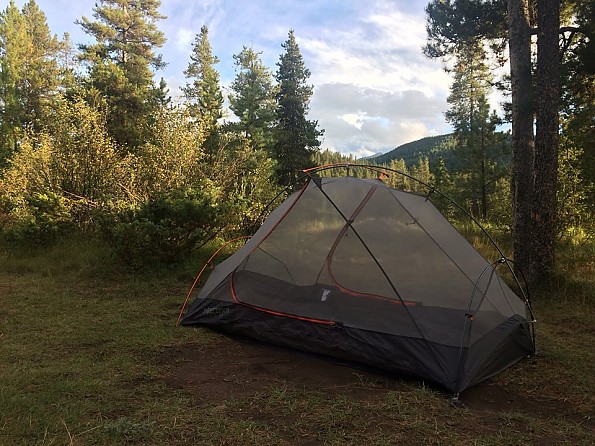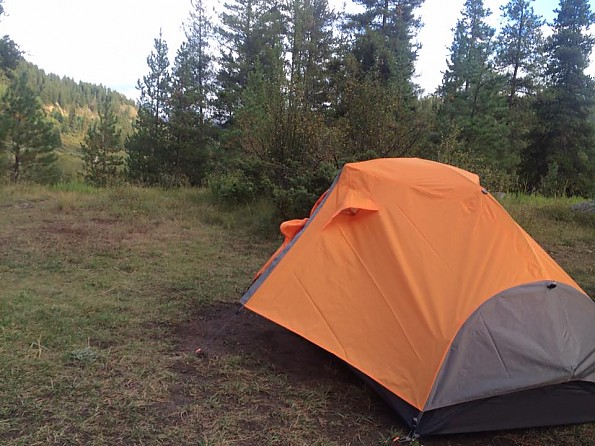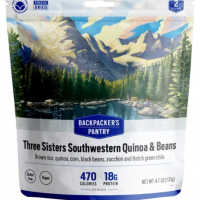Marmot Fuse 2P
The Fuse 2P has been discontinued. If you're looking for something new, check out the best three-season tents for 2024.

Not a spectacular tent, but a solid performer. It weighs in at just under four pounds, which makes it a little hefty by modern standards. What you get in exchange for the extra weight is extra room and durability. Get it on sale and enjoy it for a long time.
Pros
- Roomy
- Sturdy
- Comfortable
- Fabric doesn't stretch
- Stable in windy weather, good in rain
- Well-ventilated
Cons
- Not a ton of info from Marmot
- Not my favorite color
- Not ultralight
- Not unique
Setup: This is not a hubbed design, so it's not as simple to set up as something like the MSR Hubba Hubba NX. It's not much more complicated, though. Instructions are sparse, but just looking at the photos will help anyone figure it out. Like most tents from U.S. companies, you've got to set this one up with the inner tent first, which can be tricky in the rain.
Stability: The pitch is fairly taut. The fly is made from polyester, though, which isn't as stretchy. That means you really have to get it even when you pitch the tent if you don't want there to be flapping in the wind. There are enough guyout points for just about any three-season wind, and the DAC poles have been sturdy as can be.
Weather Resistance: You don't have to worry about seam sealing, which is not that unique. With welded seams, you also don't have to worry about the seam tape slowly peeling or otherwise degrading over time. This tent has kept us dry in plenty of downpours. The wind resistance is typical for this sort of design.
The sides are somewhat vertical, but the tent shed wind pretty well for us in a summer in the Rockies. I wouldn't want to deal with much snow loading. I was concerned with water getting in at the head and feet of the tent, since the fly doesn't go to the ground at the ends, but it was never an issue.
Ventilation: Great. The inner tent is all mesh. You can have the doors of the fly open completely if the weather is nice, which is how we almost always did it. You can have the doors open slightly even in the rain, depending on how much stuff you have under the vestibule.
Room & Storage: Nice and roomy for a 2-person backpacking tent. Larger dimensions than tents like the Big Agnes Rattlesnake or Copper Spur or the MSR Hubba Hubba NX. I'd say it's about as big inside as the REI Half Dome 2 (not the plus version), which for me always seemed luxuriously big. There is a little pocket up top that is supposed to be a sort of light diffuser, turning your headlamp into a lantern. It actually worked kinda well.
There are two other pockets for gear storage, but not really for anything bigger than an iPod or phone. The vestibules are pretty normal. One is actually bigger than the other, although this is less noticeable in person than I thought it would be. We could fit boots and a 60L pack under each vestibule, but getting out was always a hassle. The vestibules are fine, but not a reason to buy this tent.
The polyester fabric of this tent actually adds to the amount of usable space in the tent. It doesn't sag nearly as much as nylon when it gets wet, so you have that much less crouching to do when entering and exiting the tent.
Packability: Nothing to write home about here. Don't expect something as compact as the MSR Hubba Hubba. Pretty typical for a 2-person, non-ultralight tent.
Ease of Use: Not great, mostly because Marmot doesn't include instructions on how to set up the tent. Don't get me wrong—it's all pretty intuitive if you've set up a tent before, but it's nice to know that you're doing what you're supposed to do when you're bending aluminum poles to what feels like the breaking point just to get the tent set up. I really wish Marmot would include better info about this tent. Even the exact dimensions are hard to come by. Once the tent is set up, this thing is as simple as can be.
Features: The main features of this tent are the "fusion-welded" seams on the fly and the polyester material. Polyester is rare on a tent this expensive, but I like it. I had to get over the way it reminds me of the cheaper tents I've had in the past—that's just at first glance. Upon further inspection, the tent is obviously well thought out and well constructed. I like that the polyester doesn't stretch hardly at all when it's wet. Like I said before, that helps increase useable space. It should also help with weather resistance by keeping the pitch nice and taut.
The fusion welded seams? Well, it's nice not to have any any unsealed seams to worry about, I guess. No seam tape to come peeling off. It gives the tent a nice, sleek look.
Construction & Durability: It's a tough tent. High-denier fabrics sure do give a person confidence when the ground is rocky or the wind is really blowing. A footprint would only be necessary if you like to keep the bottom of your tent clean. The all-mesh interior walls are, well, mesh. The mesh will wear over time and develop runs and holes, but they should be simple to fix. In six month of use, we've had no issues.
Source: bought it new
Your Review
You May Like
Specs
| Price |
Historic Range: $197.37-$329.00 Reviewers Paid: $220.00 |





